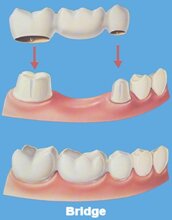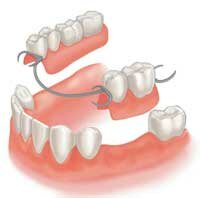A bridge is a dental device that fills a space that a tooth previously occupied. A bridge may be necessary to prevent:
- Shifting of the teeth that can lead to bite problems (occlusion) and/or jaw problems and resultant periodontal disease.
- Bridges safeguard the integrity of existing teeth and help maintain a healthy, vibrant smile.
 There are three main types of bridges, namely:
There are three main types of bridges, namely:
- Fixed bridge- this is the most popular and consists of a filler tooth that is attached to two crowns, which fit over the existing teeth and hold the bridge in place.
- The “Maryland” bridge is commonly used to replace missing front teeth and consists of a filler that is attached to metal bands that are bonded to the abutment teeth. The metal bands consist of a white-colored composite resin that matches existing tooth color.
- The Cantilever bridge is often used when there are teeth on only one side of the span. A typical three-unit cantilever bridge consists of two crowned teeth positioned next to each other on the same side of the missing tooth space. The filler tooth is then connected to the two crowned teeth, which extend into the missing tooth space or end.
Dentures and Partials
Periodontal disease, injury, and tooth decay can all cause a loss of your natural teeth. However, we can bring back the smile on your face with dentures to restore your missing teeth. With improved technology and updated materials, dentists can now make them appear more natural and more comfortable for the patient.
There are two types of dentures:
- Complete dentures cover the patient’s entire jaw
- Partial dentures, with their metal framework, replace multiple missing teeth.

Ask our doctors to see which type would be right for you.It may take some time to adjust to your dentures. Speaking and eating may feel different at first, but these regular activities will resume normally once you are accustomed to your dentures.